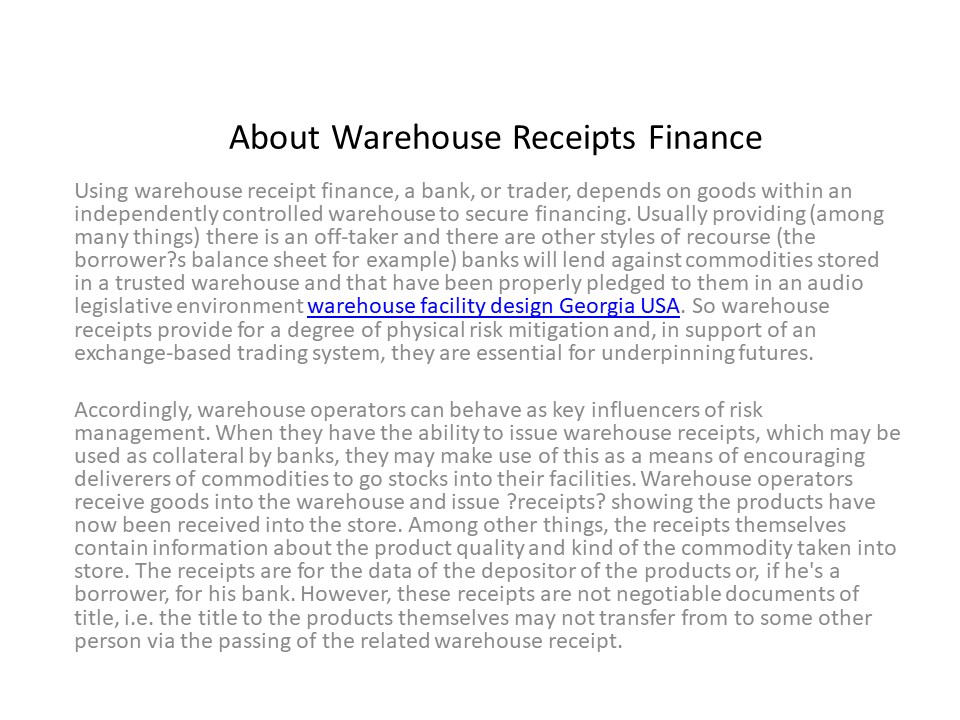warehouse facility design Georgia USA - PowerPoint PPT Presentation
Title:
warehouse facility design Georgia USA
Description:
The non-negotiable warehouse receipt in itself doesn't convey title and, if it's in the name of, like, a trading firm, it must be issued in the name of or utilized in the financial institution in order for the financial institution to obtain more than a protection interest. A security interest is significantly less attractive to a bank than if it has what is called possessory collateral, i.e. it has direct recourse to the warehouse where the goods are stored and in the event of a default or similar, it is simple for the financial institution to market the commodities in a smaller time frame. – PowerPoint PPT presentation
Number of Views:1
Title: warehouse facility design Georgia USA
1
About Warehouse Receipts Finance
- Using warehouse receipt finance, a bank, or
trader, depends on goods within an independently
controlled warehouse to secure financing. Usually
providing (among many things) there is an
off-taker and there are other styles of recourse
(the borrower?s balance sheet for example) banks
will lend against commodities stored in a trusted
warehouse and that have been properly pledged to
them in an audio legislative environment
warehouse facility design Georgia USA. So
warehouse receipts provide for a degree of
physical risk mitigation and, in support of an
exchange-based trading system, they are essential
for underpinning futures. - Accordingly, warehouse operators can behave as
key influencers of risk management. When they
have the ability to issue warehouse receipts,
which may be used as collateral by banks, they
may make use of this as a means of encouraging
deliverers of commodities to go stocks into their
facilities. Warehouse operators receive goods
into the warehouse and issue ?receipts? showing
the products have now been received into the
store. Among other things, the receipts
themselves contain information about the product
quality and kind of the commodity taken into
store. The receipts are for the data of the
depositor of the products or, if he's a borrower,
for his bank. However, these receipts are not
negotiable documents of title, i.e. the title to
the products themselves may not transfer from to
some other person via the passing of the related
warehouse receipt.
2
Herein lies the possibility of some extent of
confusion. The definition of ?warehouse receipt?
means different things to different groups of
people round the planet. As an example, in the
United States, the word ?warehouse receipt? is
employed for a report evidencing storage of a
commodity in a warehouse. Unlike elsewhere, it's
a report of title, supported by legislation in
this case the US Warehouse Receipts Act of 2000,
which replaced a bit of legislation enacted in
the US in 1916. In comparison, in the United
Kingdom a warehouse receipt is really a
non-negotiable instrument simply notifying that
at a particular moment over time a certain amount
and quality of a commodity was delivered in to a
warehouse. In the UK, a negotiable form is
represented by a warehouse ?warrant? of the sort
issued by London Metal Exchange-nominated
warehouses. The key benefits of warehouse receipt
financing from a chance management perspective
are The identity of the collateral is less
contestable and the intention of the borrower to
pledge it's clear, avoiding ownership disputes
and competing claims. The collateral could be
auctioned or sold promptly and at inexpensive if
you have a loan default A lender holding a
warehouse receipt can claim against the issuer
(the warehouse company) in addition to the
borrower in the event that the collateral goes
missing In a bankruptcy scenario a report of
title can stop the claims of competing
creditors. Warehouse receipts could be negotiable
or non-negotiable. A non-negotiable warehouse
receipt is made out to a specific party (a person
or an institution). Only this party may authorize
release of goods from the warehouse. He can also
transfer or assign the products to some other
party, like a bank. The warehouse company must
certanly be so notified by the transferor prior
to the transfer or assignment becomes effective.
3
The non-negotiable warehouse receipt in itself
doesn't convey title and, if it's in the name of,
like, a trading firm, it must be issued in the
name of or utilized in the financial institution
in order for the financial institution to obtain
more than a protection interest. A security
interest is significantly less attractive to a
bank than if it has what is called possessory
collateral, i.e. it has direct recourse to the
warehouse where the goods are stored and in the
event of a default or similar, it is simple for
the financial institution to market the
commodities in a smaller time frame. Issuers of
non-negotiable warehouse receipts include
collateral managers. They are becoming
increasingly important, with companies like ACE,
Cotecna, Control Union, Drum and SGS rolling out
collateral management products to serve a growing
international market. Notwithstanding the fact
that most bankers, borrowers and warehousemen say
they find collateral management ?just very
costly? their want to utilize the services of
collateral management companies is increasing. In
the lack of totally secure physical commodity
storage facilities and caused by the risks in
moving commodities about, banks are obliged to
get other structures for protection against
physical risks. The collateral management
agreement, or CMA, provided by a number of global
firms, offers one particular solution.































